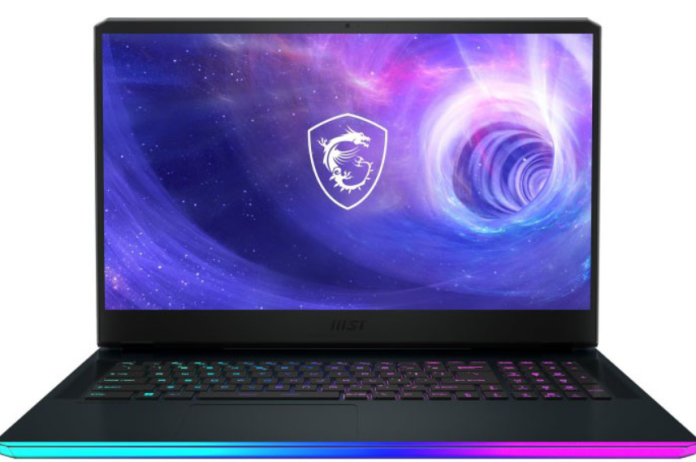MSI’s GE76 Raider has long been a favourite. They’re well-built machines that give consistent results. On the other hand, the current iteration’s exterior hasn’t changed all that much. On the inside, though, Intel’s 14-core Core i9-12900HK processor and Nvidia’s GeForce RTX 3080 Ti Laptop GPU are significantly superior. It is impressive not only by the CPU and GPU performance but also by the 1080p webcam and the powerful audio. Continue reading to find out more.
Skipping over the outward aspects of the GE76 Raider here, save to point out the massive RGB LED stripe that runs across its front, and go straight to what matters – the inside:
Raider GE76 Specs
- Intel Core i9-12900HK, 12th generation
- DDR5/4800 dual-channel memory: 32GB
- 175 Watt TGP, Nvidia GeForce RTX 3080 Ti GPU
- 3-inch, 16:9, UHD 4K resolution display with 120Hz refresh rate
- Storage: 1TB Micron 3400 PCIe 4.0 SSD
- Networking: Killer AX1675i Wi-Fi 6E, Killer E3100G 2.5GbE
- 6 x 11.2 x 1 inch, 6.4 pounds, plus 1.2 pounds for the 330 watt power brick
- Size of the battery: 99.9 Whr
- Three USB-A ports, one USB-C port, one Thunderbolt 4 port, miniDisplayPort, HDMI port
- SD Express card reader, 2.5GbE Ethernet, analogue audio jack
Trackpad And Keyboard
The GE76 Raider’s keyboard hasn’t altered much since the original 10th-generation model. It’s not our favorite keyboard, as it’s still a touch compacted for our fat sausage fingers, but it’s serviceable. It still has a 10-key on the side, as well as a telephone keyboard layout, which isn’t nearly as handy as a calculator layout.
Although the keyboard has per-key RGB backlighting with smooth transitions, it still feels dim in comparison to competitors like the Asus ROG Strix G17. The enter button is conveniently located near the 10-key on the GE76. Surprisingly, Asus misses this section on the ROG Strix G17.
The trackpad is identical to prior versions, but it’s a little too jittery out of the box and could use better palm rejection.
Subsystem For Audio
Although some people dislike huge laptops, one plus is that they usually have superior audio, which the GE76 Raider does. The laptop’s four speakers produce adequate volume, which is further boosted by the Nahmic spatializer. The noise suppression and built-in microphones are also rather effective.
Webcam
The GE76 Raider was among the first to upgrade from a 720p to a 1080p webcam. It’s a terrific choice for hosting Zoom calls with more than one person in front of it because of the relatively broad angle of view (particularly when combined with its decent speakers and microphones).
Quality Of Construction And Acoustics
Little has changed in terms of the build quality of this particular model. The good news is that it’s still a high-end gaming laptop with an aluminum lid and deck. The laptop’s bottom includes plastic hinge caps, but most people wouldn’t notice. The body is also relatively robust, so if your wrist is strong enough to lift a 6.4-pound laptop by the corner, you can do so without the laptop bending.
The GE76 Raider has six heat pipes, the majority of which are dedicated to the GeForce RTX 3080 Ti Laptop GPU. On the other hand, MSI includes a novel phase-change liquid metal pad on the CPU. The pad is solid when the temperature is below 58 degrees Celsius. The pad liquefies as the temperature rises. The concept, according to MSI, could increase not only cooling but also longevity compared to traditional liquid metal, which can crystalize with time.
The GE76 Raider’s fan noise is comparable to earlier generations. When it’s in high performance mode, it can be quite loud (about 51dB). MSI has included a Smart Auto mode with “AI” that dynamically optimizes the fans and performance to get the most out of the system. Those who need the maximum performance won’t mind the fan noise, but we’d prefer to use the laptop’s Smart Auto mode instead. When running 3DMark Time Spy in this mode, the fan noise was kept to a very low 45dB.
You might expect that going from 45dB to 51dB (a significant increase) would result in a significant performance change, but it isn’t. In fact, in 3DMark Time Spy, it equates to a performance loss of 6 to 7% in exchange for a significant reduction in noise.
Upgrades
The GE76’s laptop upgrades are standard for a large gaming laptop. For storage, there are two DDR5 SO-DIMM slots and two M.2 slots. It has a Killer/Intel Wi-Fi 6e wireless card that can be replaced. Without removing the motherboard, access is also rather simple.
Performance
Starting with Maxon’s Cinebench R20, a benchmark based on the engine used in the company’s professional Cinema4D application. The 14-core 12th generation Core i9 delivers on performance. That’s because 14 is higher than 8. The MSI GF76 Katana also boasts a 14-core CPU, albeit it isn’t overworked at default settings. It now ranks second in its performance setting. These results show the GE76 Raider can perform multi-threaded or multi-core tasks including 3D rendering, CPU-based encoding, and even extensive Excel analysis.
However, most apps do not fully utilize a system’s CPU cores. So we run Cinebench R20 on a single core or thread. Now you know how the GE76 Raider handles browsing, photo editing, and Office tasks. Due to its speed, this laptop should be the most responsive in most programs.
For a high-performance laptop, Cinebench R20 is a short running test that puts little burden on the cooling system. We provided each laptop a 30GB 1080P file to convert using Handbrake 0.9.9 and the Android Tablet preset. A shorter bar indicates a faster laptop. The GE76 Raider wins again, converting in around 13 minutes. The Asus ROG Zephyrus S17’s 8-core Core i9-11900H takes approximately five minutes to finish the task.
What’s More?
UL’s PCMark 10 application performance test to measure a laptop’s performance while using open-source Office, Photo Editing, and 3D rendering software. This test shows us that, while it’s exciting to see a great multi-core result, it’s ultimately irrelevant. That’s evident in the results for most of the computers, which are likely to be identical. Can you identify the difference between laptop A and B when you’re just typing a letter? We’d still say no, but the evidence suggests the GE76 Raider will be faster.
Let’s face it, you don’t buy a laptop with this much RGB for Zoom. We’ll start with 3DMark Time Spy from UL because you’re here for gaming. It’s a trusted synthetic graphics test that focuses on the GPU. The GE76 Raider’s GeForce RTX 3080 Ti is included in the final score, but what does it offer that other laptops don’t? Nearly a quarter point higher.
Because Time Spy is a more traditional DirectX12 game benchmark, we used 3DMark’s Port Royal test to analyse ray tracing. The GeForce RTX 3080 Ti boasts 20% more ray-tracing and CUDA cores than the GeForce RTX 3080. The MSI GE76 Raider’s increased power and heat constraints give it a 23% lead over the next fastest laptop in our list.
Real games matter, too, so we run Rise of the Tomb Raider in DX11 mode at 1080p resolution. The CPU is definitely used more in this older game, but the GPU still rules. The GE76 Raider surpasses the competition, including a stack of laptops with GeForce RTX 3080 GPUs.
Digging In More Details
Now we’ll look at a game that puts additional strain on the GPU. Metro Exodus is set to Extreme in 1080p to put the laptop through its paces. With an 11th generation Core i9 and RTX 3080, the GE76 Raider clearly outperforms all other gaming laptops in our test.
The final test looks at battery life, which is crucial to some. People who expect their laptops to work on 4K screens with high-power CPUs and GPUs are “using it wrong.” Aviation laws prohibit large lithium ion batteries on planes, thus all laptop batteries today are limited to 100 watt hours.
With a fixed “gas tank,” high-performance parts won’t provide you very long battery life when performing things like gaming. Years of saying an hour or two dependents on the game and laptop haven’t changed.
The main point is that overclocking the CPU or GPU reduces battery life (yes, you too M1 Max fans). Watching a video may give better battery life than you think.
For that test, we looped a 4K movie file with the laptop in aero plane mode and ear buds connected in. The goal is to imitate watching a movie in a darkened plane or office.
Considering its big 17.3-inch 4K panel, the GE76 Raider’s 99.9 watt-hour battery provides decent battery life. High density screens require more illumination to match a lesser resolution screen’s brightness.
The GE76 Raider’s movie playback duration was around 6.5 hours, which is competitive with lower-resolution screens (albeit smaller batteries, too). Basically, battery life is fair for light workloads and poor for heavy loads.
Conclusion
The GE76 Raider is now faster than ever! A lazy reviewer trying to get mentioned in corporation ad-copy The truth is, this laptop outperforms prior models by a wide margin.
The GE76 Raider was first seen in early 2020 with an Intel 8-core Core i7-10870H. Two years later, the new model has an 85% increase in multi-core performance.
It doesn’t have that edge in single-core performance, but a 58% improvement isn’t bad. The GE76 Raider’s only flaw is the GeForce RTX 3080 Ti, which falls short of our expectations. On paper, the GeForce RTX 3080 Ti adds 20% more shader and ray tracing cores, but in practice it adds 4–12% more. That’s decent but not as punchy as expected.
The price is something worth moaning about. The GE76 Raider 12UHS costs $4,200 with a 4K UHD 120Hz panel, a 12th gen Core i9, and a GeForce RTX 3080 Ti Laptop GPU. That’s a big amount of change.
Finally, while the GE76 Raider may use a refresh, we can’t complain about a laptop that offers a significant performance gain over a two-year-old model.








